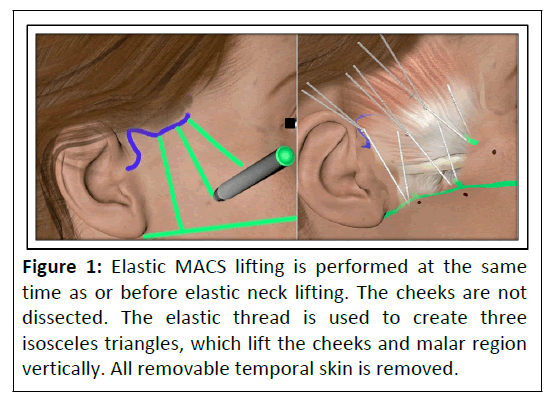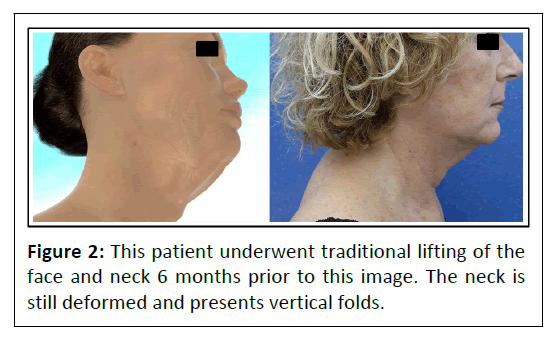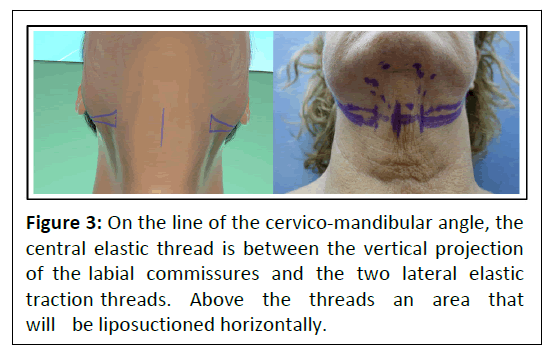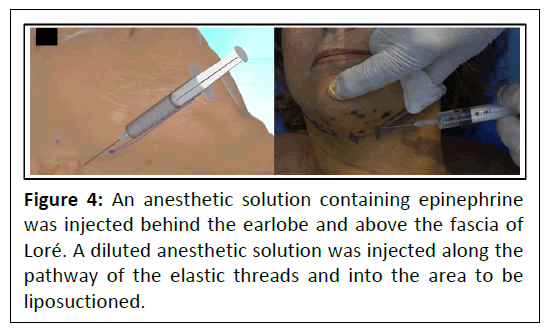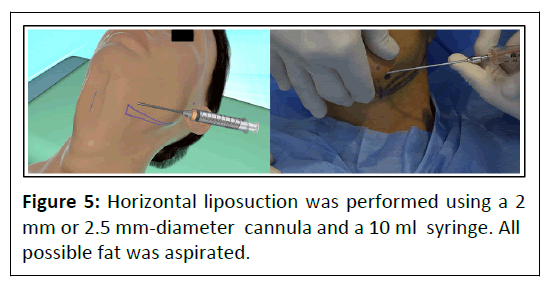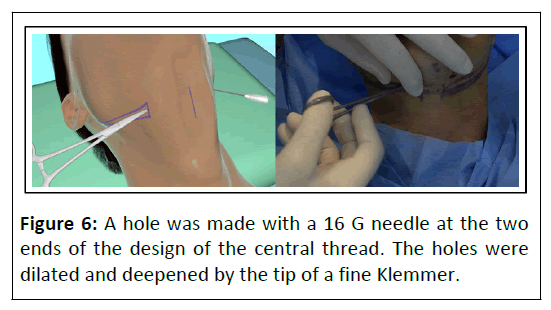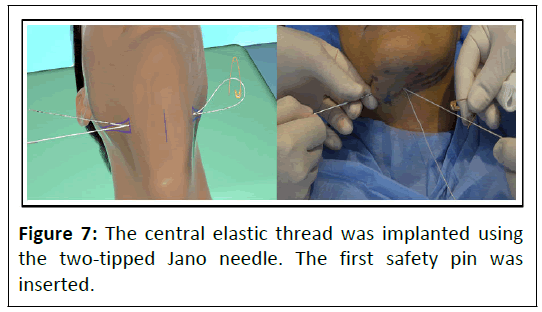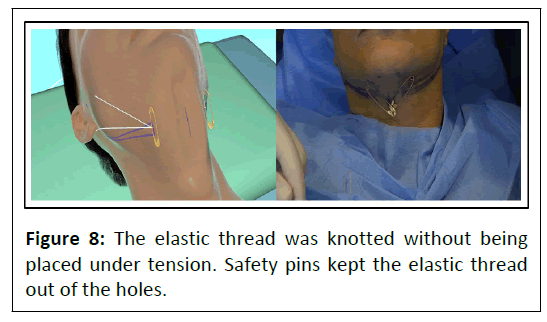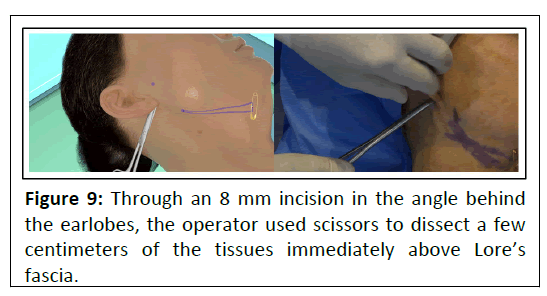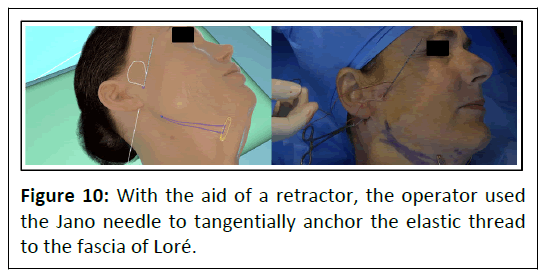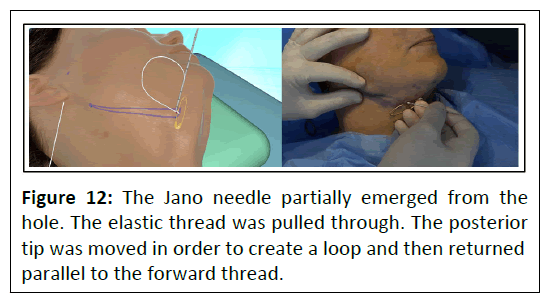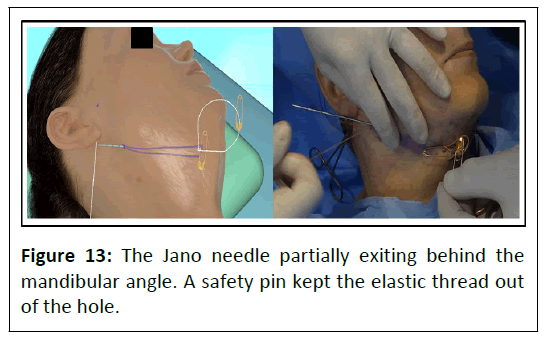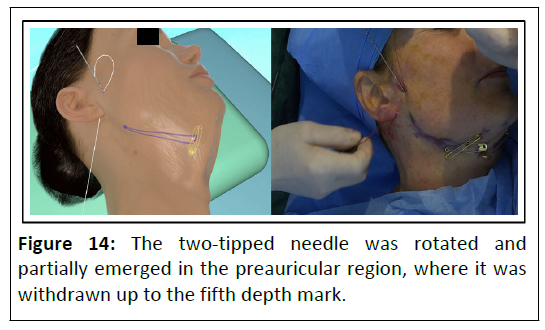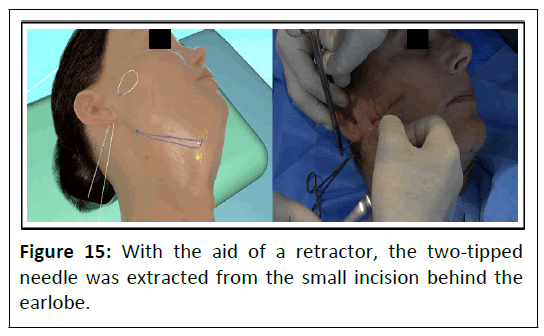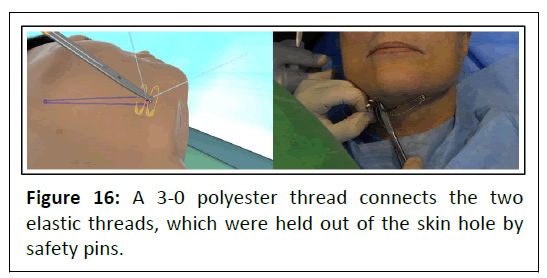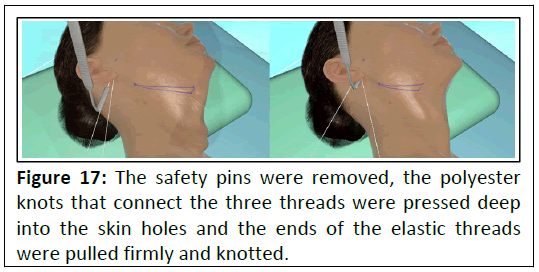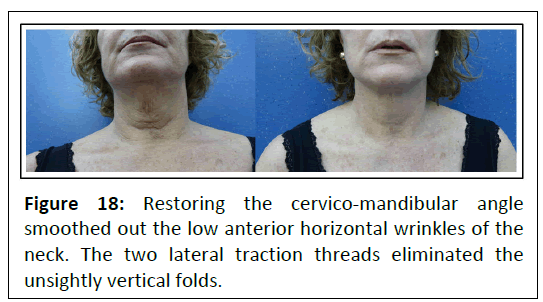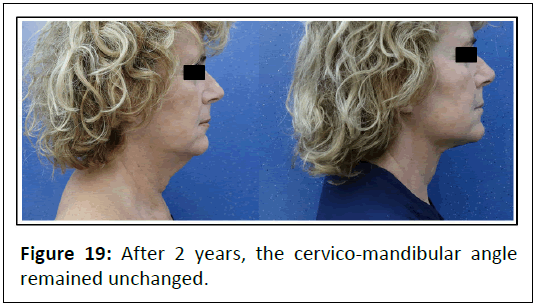Elastic Neck Lift with Three Threads and Four Safety Pins: A New Approach to Neck Lifting
Sergio Capurro*
Department of Plastic Surgery, Capurro Clinic, Genoa, Italy
Published Date: 2023-12-25DOI10.36648/2472-1905.9.4.164
Sergio Capurro*
Department of Plastic Surgery, Capurro Clinic, Genoa, Italy
- *Corresponding Author:
- Sergio Capurro
Department of Plastic Surgery,
Capurro Clinic, Genoa,
Italy,
E-mail: sergio.capurro@hotmail.it
Received date: November 24, 2023, Manuscript No. IPARS-23-18157; Editor assigned date: November 27, 2023, PreQC No. IPARS-23-18157 (PQ); Reviewed date: December 11, 2023, QC No. IPARS-23-18157; Revised date: December 18, 2023, Manuscript No. IPARS-23-18157 (R); Published date: December 25, 2023, DOI: 10.36648/2472-1905.9.4.164
Citation: Capurro S (2023) Elastic Neck Lift with Three Threads and Four Safety Pins: A New Approach to Neck Lifting. J Aesthet Reconstr Surg Vol.9 No.4: 164.
Abstract
Background: Although surgical techniques for neck correction yield good immediate post-operative results, persistent results are not achieved over time. Even if the anterior region of the neck is completely dissected and the platysma manipulated, the medium and long-term results are often unsatisfactory. Moreover, these procedures are demanding, traumatic, can create iatrogenic deformities and sometimes require long post-operative recovery. Using the two-tipped Jano needle and elasticum thread, the tissues of the cheeks and neck are not dissected, but simply repositioned under local anesthesia. Here, we present a technique for elastic lifting with safety pins that is simpler than the previous technique and permanently eliminates the most evident defects of the neck.
Methods: Sagging neck skin is largely due to ptosis of the cheeks, which we corrected by elastic MACS lifting. After the vertical ptosis of the cheeks has been corrected, if a poorly shaped neck remains, we can perform elastic neck lifting with three threads and four safety pins. Once joined together, the three elastic threads eliminate the vertical folds of the neck, lift the low horizontal folds and restore the profile of the cervico-mandibular angle.
Conclusion: Elastic neck lifting with three threads and four safety pins is a simple technique that enables the main defects of the anterior region of the neck to be corrected under local anesthesia. In addition to restoring the cervico-mandibular angle, this new operation enables elimination of unsightly vertical folds of the neck without any need for tissue dissection or manipulation.
Keywords
Anterior neck flaccidity; Neck rejuvenation; Neck lift; Platysmal bands; Cervico-mandibular angle; Submental liposuction; Elastic neck lift; Elastic MACS lift; Elasticum thread; Jano needle
Introduction
The objective is to obtain a neck with a well-defined cervicomandibular angle and without unsightly vertical folds. Unfortunately, this objective does not seem to be achievable in a stable manner. Traditional neck lifts often yield disappointing short or long-term results that do not reflect the operator's efforts (extensive dissection and manipulation of the platysma) [1]. Patients who undergo these operations must be prepared to accept a high risk of iatrogenic deformities and there is a significant risk of failure to maintain the results in the long-term [2].
Even in the least invasive operations, such as closed platismotomy, the bands can recur [3]. Labbé, et al., [4] developed a technique in which the platysma is sutured to fascia of Loré’. Fogli, et al., [5] described a method of anchoring the platysma muscle to the prelobar fibrous tissue of Lore's fascia. Gonzalez [6] then utilized an overlapping plication of the platysma. After vertical incision and blunt dissection, the lateral edge of the platysma muscle is pulled posteriorly and cephalically and fixed just below the mandibular angle.
Extensive dissection and manipulation of the platysma can cause post-operative hematomas, which can lead to skin necrosis. Smoking also increases the risk of necrosis. For these reasons, we have eliminated dissection from our neck-lifting procedures, just as we eliminated it in lifting the cheeks [7,8].
Using elastic thread mounted on a two-tipped needle, we reposition the neck tissues under local anesthesia. Elastic neck lifting with three threads and four safety pins is the most recent elastic lifting procedure with safety pin lifts and follows the 8-pin neck lift [9]. Its efficacy is comparable to implantation of the elastic thread between the two fasciae of Loré performed at the same time as horizontal liposuction of the neck [10].
Sagging neck skin is often caused by ptosis of the cheeks and can be corrected by elastic MACS lifting alone (Figure 1). In patients with moderate ptosis of the face and neck, we normally perform elastic MACS lifting and simple elastic neck lifting, which is achieved by implanting an elastic thread between the two fasciae of Loré.
This thread is implanted through the same access used for the elastic MACS lift. In patients with severe ptosis of the face and neck, elastic MACS lifting and elastic neck lifting with three threads and four safety pins can be performed during the same session.
Materials and Methods
The patient in Figure 2 had undergone face and neck lifting 6 months prior. Lifting of the cheeks had been quite effective, as the skin at the sideburn could not be pinched between the fingers. In contrast, the neck lift had left evident ptosis of the tissues, platysmal folds and no definition of the cervicomandibular angle. Under local anesthesia horizontal liposuction of the anterior excess fat will be performed and three elastic sutures (Elasticum EP 3.5 Korpo) will be implanted in the neck. The elastic thread equipped with a two-tipped needle repositions the skin and subcutaneous tissues, restoring the aesthetic conformation of the neck. The thread is impalpable and colonized by connective tissue cells, became a "ligament", stabilizing the result.
Pre-operative design
A vertical line is drawn in the center of the neck. Two small lateral lines are then drawn on the line that represents the future cervico-mandibular fold, corresponding with the vertical projection of the labial commissures (Figure 3). Between these two lines, the first elastic thread is implanted. At the ends of the lateral elastic threads, two traction loops are created, which eliminate the vertical folds of the neck skin. To draw the cervicomandibular angle, the patient bends their neck and the tissues over the angles of the mandible are pulled upward. This line runs outward to the corner of the jaw and extends to the fascia of Loré. The return path of the elastic thread reaches the loop of the central elastic thread. The two lateral elastic threads are parallel and about 1 cm apart.
Local anesthesia
A local anesthetic containing adrenaline (1/2 mg adrenaline in 10 ml 2% lidocaine) is injected behind the earlobes first and then above the fascia of Loré. A dilute solution of anesthetic is injected along the pathway of the elastic threads and finally in the areas where excess fatty tissue was palpated (Figure 4).
Horizontal liposuction
Horizontal liposuction is performed through a hole made by a 16 G needle or a small skin incision. A 2 mm or 2.5 mm diameter cannula is used (Figure 5). After neck liposuction, compression is needed for 2-3 weeks.
Implanting the central elastic thread
The central elastic thread is implanted between the two small lateral lines to correspond with the vertical projection of the labial commissures. With a 16 G needle, a hole is made on each of the two small lateral lines. A fine-tipped Klemmer is used to dilate and deepen the holes (Figure 6).
The Jano needle is inserted perpendicularly into the entry hole to a depth of just over 5 mm. The needle then travels horizontally, partially exiting from the hole at the other end, where it is extracted up to the 5th depth mark. The tip is moved slightly to the side and the needle returned to the entry hole (Figure 7), where it is completely withdrawn.
A safety pin is used to hold the thread outside the hole. The two ends of the elastic thread are knotted without traction. The elastic thread is held outside the entry hole by a second safety pin (Figure 8).
Implanting the lateral elastic threads
Next, the two lateral elastic threads are implanted. The operator makes an 8 mm incision behind the earlobes. Using scissors, the operator lifts the tissues immediately above Lore’s fascia (Figure 9) and inserts a retractor.
The Jano needle enters the small incision and anchors the elastic thread tangentially in the fascia (Figure 10). The needle is partially extracted up to the fifth depth mark, rotated and follows the pre-established pathway in the subcutaneous tissue, passing outside the corner of the jaw (Figure 11).
Once beyond the jaw, the two-tipped needle is extracted up to the fifth depth mark, rotated and follows the previously drawn line, partially emerging from the hole. During the procedure, the operator makes up/down movements with the Jano needle to check that no skin introflections occur. The elastic thread is pulled through. As always, a Klemmer is attached to the end of the thread. The Jano needle is extracted until just over 5 mm remains in the tissue. It is then tilted and changes direction to create the traction loop (Figure 12).
Once this loop is created, the Jano needle travels parallel to the previously implanted elastic thread, in the direction of the mandibular angle. The distance between the two elastic threads is about 1 cm. The resistance to traction is determined by the tissues situated between the two threads.
After reaching the angle of the jaw, the Jano needle is extracted up to the fifth depth mark (Figure 13), rotated and then reaches the preauricular region, where it partially emerges (Figure 14).
The Jano needle is extracted up to the last depth mark, tilted and with the aid of a retractor, emerges from the small incision behind the earlobe (Figure 15).
Joining the three threads
The elastic threads (central and lateral) are joined by a 3-0 polyester thread (Figure 16). The safety pins are removed and the knot pressed deep into the hole (Figure 17).
Under the guidance of a retractor, the two ends of the elastic thread are firmly pulled and knotted. The small incision behind the earlobe is sutured with a rapidly absorbable thread to end the procedure.
Results
The tissues were repositioned and the neck regained its youthful shape (Figures 18 and 19). The patient applied an antibiotic ointment until the rapidly absorbable stitches fell out spontaneously.
In the twenty-two procedures performed thus far, the results have been satisfactory and persistent over time. In two patients, neck lifting was completed with excision of a vertical lozenge of skin and fat extending from immediately under the chin up to the new cervico-mandibular angle. In one patient with very flaccid skin, we enhanced the volume of the mandible by adipofilling with small lobular fragments, obtaining a good result. In one patient with low hyoid bone, we implanted another elastic thread between the two Lore’s fascia to further define the cervico-mandibular angle. In two patients, roughness of the lower neck skin was treated with cellular adipofilling via intradermal injection [11].
Discussion
Sagging of the cheek skin impacts both the neck and the edge of the jaw. The vertical component of gravitational ptosis is corrected by performing elastic lifting of the middle third [12] and, if the tissues at the sideburn can be pinched between the fingers, by elastic MACS lifting (Figure 1). In elastic MACS lifting, the temporal region is dissected up to a point just beyond the zygomatic arch and all excess skin removed. Elastic lifting of marionette wrinkles [13] corrects any oblique laxity of the cheek. If there is excess skin, the pre-auricular skin is removed without dissection. Elastic neck lifting with three threads and four safety pins can be performed through the incision used for elastic MACS lifting by creating a tunnel immediately above the fascia of Loré. This new neck-lifting technique is most frequently performed through an 8 mm skin incision behind the earlobes. The main indications are the presence of excess neck tissue, vertical platysmatic folds and the absence of a cervicomandibular angle.
Conclusion
The techniques that we are developing are part of what we call elastic plastic surgery. Interventions on the face and especially the neck are becoming popular in Italy and South Korea [14]. In elastic facial surgery, the most important consideration is that, no dissection of the neck and cheek is required.
References
- Pelle-Ceravolo M, Angelini M, Silvi E (2016) Complete platysma transection in neck rejuvenation: A critical appraisal. Plast Reconstr Surg 138: 781-791.
[Crossref], [Google Scholar], [Indexed]
- Batniji RK (2014) Complications/sequelae of neck rejuvenation. Facial Plast Surg Clin North Am 22: 317-320.
[Crossref], [Google Scholar], [Indexed]
- Daher JC (2011) Closed platysmotomy: A new procedure for the treatment of platysma bands without skin dissection. Aesthetic Plast Surg 35: 866-77.
[Crossref], [Google Scholar], [Indexed]
- Daniel L, Franco RG, Nicolas J (2006) Platysma suspension and platysmaplasty during neck lift: Anatomical study and analysis of 30 cases. Plast Reconstr Surg 117: 2001-2007.
[Crossref], [Google Scholar], [Indexed]
- Fogli A, Desouches C (2008) Less invasive face-lifting: Platysma anchoring techniques. Clin Plast Surg 35: 519-529.
[Crossref], [Google Scholar], [Indexed]
- Gonzalez R (2014) The LOPP-lateral overlapping plication of the platysma: An effective neck lift without sub-mental incision. Clin Plast Surg 41: 65-72.
[Crossref], [Google Scholar], [Indexed]
- Hodgkinson D (2021) Total neck rejuvenation, harnessing the platysma in the lower neck and décolletage. Aesthetic Plast Surg 46: 161-172.
[Crossref], [Google Scholar], [Indexed]
- Capurro S (2017) Basic elastic MACS and neck lift without dissection of the cheeks and neck, step-by-step. CRPUB Medical Video Journal. Elastic plastic surgery section.
- Capurro S (2017) Elastic lifting of the neck with safety-pins, without neck dissection and without skin removal. CRPUB Medical Video Journal. Elastic plastic surgery section.
- Capurro S, Rava C (2013) Liposuction and immediate implantation of an elastic thread between the two fasciae of Loré to treat a double chin. CRPUB Medical Video Journal. Elastic plastic surgery section.
- Capurro S (2018) Subcutaneous volumetric Adipofilling® and intradermal regenerative Adipofilling for the treatment of wrinkles and aged skin. CRPUB Medical Video Journal. Adipofilling section.
- Capurro S (2007) Elastic lifting of the cheeks without blunt dissection. CRPUB Medical Video Journal. Elastic plastic surgery section.
- Capurro S (2022) Elastic lifting of marionette wrinkles. J Aesthet Reconstr Surg 8: 1-5.
- Hwang K, Kim H, Kim YR, Na Y (2016) Improvements in the cervical angle and anthropometric distances using elasticum suspension. Plast Aesthet Res 3: 384-389.
[Crossref], [Google Scholar]
Open Access Journals
- Aquaculture & Veterinary Science
- Chemistry & Chemical Sciences
- Clinical Sciences
- Engineering
- General Science
- Genetics & Molecular Biology
- Health Care & Nursing
- Immunology & Microbiology
- Materials Science
- Mathematics & Physics
- Medical Sciences
- Neurology & Psychiatry
- Oncology & Cancer Science
- Pharmaceutical Sciences
